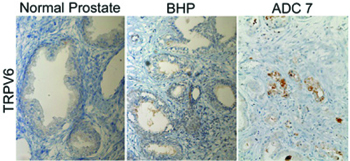Overview
- Peptide (C)NRGLEDGESWEYQI, corresponding to amino acid residues 712-725 of human TRPV6 (Accession Q9H1D0). Intracellular, C-terminus.

 Western blot analysis of Human PC-3 prostate cancer cell lysate:1. Anti-TRPV6 Antibody (#ACC-036), (1:200).
Western blot analysis of Human PC-3 prostate cancer cell lysate:1. Anti-TRPV6 Antibody (#ACC-036), (1:200).
2. Anti-TRPV6 Antibody, preincubated with TRPV6 Blocking Peptide (#BLP-CC036).
- Human LNCaP cells (Lallet-Daner, H. et al. (2009) Oncogene 28, 1792.).
 Expression of TRPV6 in rat DRGImmunohistochemical staining of rat dorsal root ganglion (DRG) using Anti-TRPV6 Antibody (#ACC-036), (1:100). A. TRPV6 channel (red) in DRG neurons. B. Staining with mouse anti-Parvalbumin (green) in the same DRG section. C. Confocal merge of TRPV6 and Parvalbumin demonstrates colocalization (arrows).
Expression of TRPV6 in rat DRGImmunohistochemical staining of rat dorsal root ganglion (DRG) using Anti-TRPV6 Antibody (#ACC-036), (1:100). A. TRPV6 channel (red) in DRG neurons. B. Staining with mouse anti-Parvalbumin (green) in the same DRG section. C. Confocal merge of TRPV6 and Parvalbumin demonstrates colocalization (arrows).
 Expression of TRPV6 in PC-3 cellsImmunocytochemical staining of paraformaldehyde-fixed PC-3 cells with Anti-TRPV6 Antibody (#ACC-036), (1:100) followed by goat anti-rabbit-AlexaFluor-555 secondary antibody (A) or with a mixture of Anti-TRPV6 Antibody and TRPV6 peptide antigen (1:20) (B). Hoechst 33342 is used as the counterstain (blue).
Expression of TRPV6 in PC-3 cellsImmunocytochemical staining of paraformaldehyde-fixed PC-3 cells with Anti-TRPV6 Antibody (#ACC-036), (1:100) followed by goat anti-rabbit-AlexaFluor-555 secondary antibody (A) or with a mixture of Anti-TRPV6 Antibody and TRPV6 peptide antigen (1:20) (B). Hoechst 33342 is used as the counterstain (blue).
- Montell, C. et al. (2002) Mol. Cell. 9, 229.
- Clapham, D.E. (2003) Nature 426, 517.
- Moran, M.M. et al. (2004) Curr. Opin. Neurobiol. 14, 362.
- Clapham, D.E. et al. (2003) Pharmacol. Rev. 55, 591.
- Gunthorpe, M.J. et al. (2002) Trends. Pharmacol. Sci. 23, 183.
- Hoenderop, J.G. et al. (2003) Pflugers. Arch. 446, 304.
- Peng, J.B. et al. (2003) J. Physiol. 551, 729.
- Fixemer, T. et al. (2003) Oncogene 22, 7858.
- Wissenbach, U. et al. (2001) J. Biol. Chem. 276, 19461.
TRP channels are a large family (about 28 genes) of plasma membrane, non-selective cationic channels that are either specifically or ubiquitously expressed in excitable and non-excitable cells.1 According to IUPHAR the TRP family comprises of three main subfamilies on the basis of sequence homology; TRPC, TRPM and TRPV (to date, three extra subfamilies are considered to belong to the TRP family; the TRPA, TRPML, and TRPP).1-4 The TRPV subfamily consists of six members, TRPV1-6.5
TRPV6 (CaT1) and TRPV5 (ECaC) are unique members of the TRP family. Both are epithelial calcium channels, form constitutively open channels, share high degree of homology (about 66%) with differences in the N and C-terminus. TRPV6 and TRPV5 are expressed in a 1,25-dihydroxyvitamin D3 dependent manner. In contrast to other members of the TRP family, TRPV6 and TRPV5 are highly Ca2+ selective and are expressed in Ca2+ transporting epithelia where they are assumed to have an important role in Ca2+ reabsorption. TRPV6 is highly expressed in the placenta, small intestine and kidney.6,7
While not being expressed in benign prostate tissue, TRPV6 was found to be upregulated in prostate cancer tissue and correlation between expression and tumor grade was shown. Finally, TRPV6 was suggested as prognostic marker and as a promising candidate for therapeutic strategies.8,9
Application key:
Species reactivity key:
Alomone Labs is pleased to offer a highly specific antibody directed against an intracellular epitope of the human TRPV6. Anti-TRPV6 Antibody (#ACC-036) can be used in western blot, immunoprecipitation, immunocytochemistry and immunohistochemistry applications. It has been designed to recognize TRPV6 from human, rat, and mouse samples.
 Expression of TRPV6 in prostate cancer.Immunohistochemical staining of human prostate tissue using Anti-TRPV6 Antibody (#ACC-036). Very low expression of TRPV6 is observed in normal (right panel) and benign hyperplasia (middle panel) as opposed to significant expression in prostate adenocarcinoma.Adapted from Raphael, M. et al. (2014) Proc. Natl. Acad. Sci. U.S.A. 111, E3870.
Expression of TRPV6 in prostate cancer.Immunohistochemical staining of human prostate tissue using Anti-TRPV6 Antibody (#ACC-036). Very low expression of TRPV6 is observed in normal (right panel) and benign hyperplasia (middle panel) as opposed to significant expression in prostate adenocarcinoma.Adapted from Raphael, M. et al. (2014) Proc. Natl. Acad. Sci. U.S.A. 111, E3870.Applications
Citations
- Rat brain lysate (1:1000).
Park, S.Y. et al. (2020) J. Chem. Neuroanat. 105, 101767.
- Human LNCaP cells.
Lallet-Daner, H. et al. (2009) Oncogene 28, 1792.
- Rat brain sections (1:500).
Park, S.Y. et al. (2020) J. Chem. Neuroanat. 105, 101767. - Rat epididymis sections.
Gao, da Y. et al. (2016) J. Gen. Physiol. 148, 161.
- Human LNCap cells.
Lehen’kyi, V. et al. (2011) PLoS ONE 6, e16856.
- Raphael, M. et al. (2014) Proc. Natl. Acad. Sci. U.S.A. 111, E3870.
- Kim, S.Y. et al. (2013) Cell Calcium 53, 102.
- Hatano, R. et al. (2012) Kidney Int. 83, 41.
- Sprekeler, N. et al. (2012) Reprod. Biol. Endocrinol. 10, 66.
- Yang, S.S. et al. (2010) Endocrinology 151, 1829.
- Choi, Y. et al. (2009) Biol. Reprod. 81, 1122.
- Lee, B.M. et al. (2009) Reprod. Biol. Endocrinol. 7, 1.
- Semenova, S.B. et al. (2009) Am. J. Physiol. 296, C1098.
- Irnaten, M. et al. (2008) Cell Calcium 44, 441.
- Lehen’kyi, V. et al. (2007) Oncogene 26, 7380.
- Lehen’kyi, V. et al. (2007) J. Biol. Chem. 282, 22582.
